
Original Link: https://www.anandtech.com/show/2822/asus-eee-pc-1005ha-refining-the-netbook
ASUS Eee PC 1005HA: Refining the Netbook
by Jarred Walton on August 20, 2009 4:00 AM EST- Posted in
- Laptops
The rate of change within the computer industry is frequently startling. [Maybe someone could plot the derivative….] Case in point, netbooks have now been in the market for nearly two years, and pretty much every major player within the computer industry has a competing offering. In just two short years, features, battery life, and even performance have increased significantly. We recently looked at the MSI Wind U123 and ASUS 1000HE, two of the first netbooks to ship with Intel's latest Atom N280 processor. Compared to previous netbooks using the N270, not much changed -- we are after all looking at a meager 4% clock speed increase. Compared to older netbooks, however, we've seen a decent performance jump relative to the initial Eee PC 2G/4G's Celeron M900.
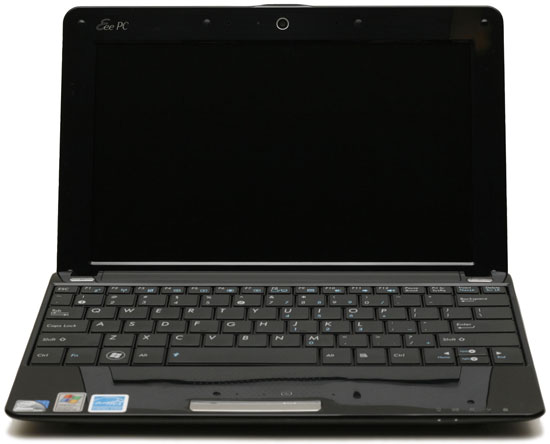
Today we have the latest iteration of the ASUS Eee PC, the 1005HA. Very little has changed relative to the 1000HE/1000HA -- and the primary difference between those two is the use of a larger battery in the 1000HE along with an option to get either an N280 or N270. ASUS is still using a 10.1" LCD, but they have switched to a different battery again and have increased the specified battery life to 10.5 hours (from 9.5 hours). The casing has also changed a bit, as it's now a lot more difficult to access the hard drive.
We've also revamped our netbook testing since last article, adding some additional tests and providing more details than before. Unfortunately, we were unable to run all of the new tests on previously reviewed netbooks, but we do have several netbook reviews in the pipeline and we will provide results from those models where possible. Outside of battery life, something that varies based on installed components and features, most netbooks will have similar performance. That being the case, any extra features as well as usability, design and pricing are largely going to determine what users will want to purchase.
ASUS Eee PC 1005HA -- Specifications and Overview
As stated, little has changed in terms of specifications since the ASUS 1000HE. All we can say for sure is that battery life has improved and the casing is slightly different. In addition, the 1005HA costs about $20 more than the 1000HE. Here's a rundown of the features of the ASUS 1005HA.
| ASUS Eee PC 1005HA Specifications | |
| Processor | Intel Atom N270 or N280 (Tested) N280: 1.66GHz, 512KB L2, 45nm, 667FSB |
| Chipset | Intel 945GSE + ICH7MU |
| Memory | 1x1024MB DDR2-533 @ 4-4-4-12 Timings |
| Graphics | Integrated Intel GMA 950 |
| Display | 10.1" Glossy LED-Backlit ~16:9 WSVGA (1024x600) |
| Hard Drive | 2.5" 160GB 5400RPM 7MB (Hitachi HTS543216L9SA00) |
| Networking | Atheros AR8132 Fast Ethernet Atheros AR9285 802.11n WiFi |
| Audio | Realtek AL269 2-Channel HD Audio (2.0 Speakers with headphone/microphone jacks) |
| Battery | 6-Cell 11.25V, 5600 mAhr, 63.0 Whr |
| Front Side | None |
| Left Side | Heat Exhaust Kensington Lock 1 x USB 2.0 VGA AC Power Connection |
| Right Side | SD/MMC reader Microphone/Headphone Jacks 2 x USB 2.0 100Mb Fast Ethernet |
| Back Side | None |
| Operating System | Windows XP Home SP3 |
| Dimensions | 10.31" x 7.01" x 1.02"-1.44" (WxDxH) |
| Weight | 2.8 lbs (with 6-cell battery) |
| Extras | 1.3MP Webcam Super Hybrid Engine (software over/under clocking) Available in White, Black, Blue, and Pink |
| Warranty | 1-year standard ASUS warranty (USA) Extended warranties available |
| Price | Black 1005HA-PU1X-BK starting at $381 |
We will see later whether we can reach the claimed 10.5 hours of battery life. The other features are typical of current netbooks, with minor bonus points for the inclusion of 802.11n WiFi. ASUS also provides a software utility to overclock (FSB to 680, CPU to 1.70GHz) or underclock (FSB to 566, CPU to 1.42GHz) the CPU/FSB/RAM. The overclock is too small to matter, though we might say the same about the N280 compared to the N270. The underclock is better, providing a slight (5.6%) increase in battery life . On the default "Auto" mode, the Super Hybrid Engine will run the CPU at full performance on AC power and underclock by 12% when you switch to battery power. The utility isn't going to radically alter your experience, but we certainly won't fault ASUS for its inclusion.
Before we get to the testing, here's a closer look at the system. We found a few other minor differences between the 1005HA and 1000HE in the exterior design.
So what differences do we find? First, there's the change in the casing on the bottom. Previously a larger panel provided access to both the memory slot and the hard drive; now you get a small panel that only provides access to the memory. If you want to upgrade your hard drive, you will now need to pry apart the chassis after removing additional screws. It's not particularly difficult on any notebook, but the change is a little odd. The other change we see is that the 1005HA has a new touchpad, and this isn't necessarily an improvement either. The new touchpad is part of the casing, with small bumps that help you find the limits of the touchpad area. It works about as well as any other touchpad we've used, but we're not sure why ASUS felt the need to undertake such a minor casing redesign. It's also possible that the LCD panel is different from the panel used in the 1000HE, which may help to account for the improved battery life.
If we had one complaint with the appearance, it would be the glossy surfaces. We understand manufacturers are sometimes stuck with glossy LCD panels because that's where the market has been going lately. Laptop casings on the other hand are firmly in the control of the laptop manufacturers. There's no reason we can't get some netbooks that don't have super glossy exteriors that show off every little fingerprint or smudge. ASUS has multiple Eee PC colors; can't we at least get one matte finish option? For what it's worth, white netbooks don't have as much of a problem with showing smudges. The black netbooks on the other hand… if you like to keep your netbook exterior clean, you'd better plan to carry around a cloth to wipe it down after each use.
Netbook Testing Setup
For our performance tests, we're sticking with PCMark05 and adding 3DMark03 and 3DMark05 into the mix to give you an idea of relative 3D/graphics performance. We've also added a couple video encoding benchmarks along with CINEBENCH. Suffice it to say, you don't want to do any video encoding or 3D rendering on a netbook! Given the similarity in overall performance among the various netbooks, we are also providing detailed results from PCMark05 so you can better understand what the composite score means.
We are also including a couple entry-level notebooks in the testing results, the Gateway NV52 and NV58. These two notebooks are a good representation of the current AMD and Intel mobile platforms, and they represent the next step up from the $300-$375 netbook price range. The Gateway NV52 currently costs about 30% more than the 1005HA, while the Gateway NV58 costs about 50% more. As you might expect, you get substantially more performance from either notebook… and substantially less battery life, plus a package that weighs twice as much. The NV52 will show up in the charts in dark green (AMD) while the NV58 is in gold (Intel); feel free to ignore those results if you're only interested in netbooks, but it does help illustrate the differences between the netbook and laptop markets.
For reference, here are links to the specifications for the other netbooks and laptops we've tested. We are also including results from two other netbooks in this review, the Acer Aspire One 751h and the GIGABYTE Booktop M1022. The Acer uses a larger 11.6" LCD along with a lower power (and lower performance) Intel Atom Z520 (1.33GHz) and an MID (Mobile Internet Device) chipset with Intel GMA 500 graphics. Specifications for the Booktop M1022 are virtually identical to the ASUS 1005HA, other than the battery. Full reviews of these two netbooks will be posted in the near future. Again, note that testing procedures have changed relative to some of the previous results, so only results run using the current procedures are included. Unfortunately, we don't have the previously tested netbooks so we aren't able to rerun the necessary tests.
ASUS 1000HE
Gateway NV52
Gateway NV58
MSI Wind U123
Now let's look at the test results.
Netbook Performance Comparison
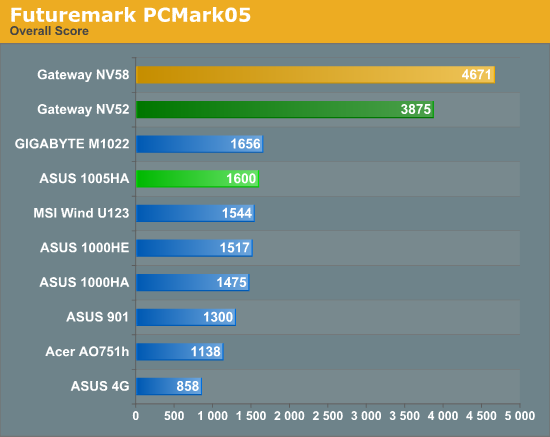
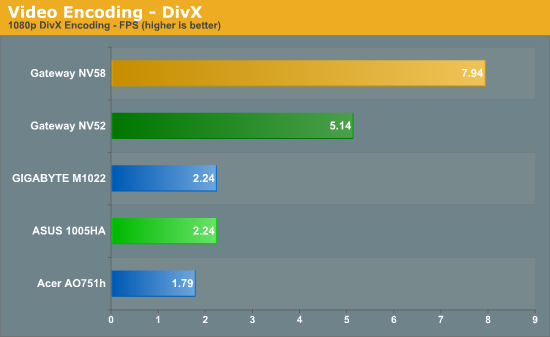
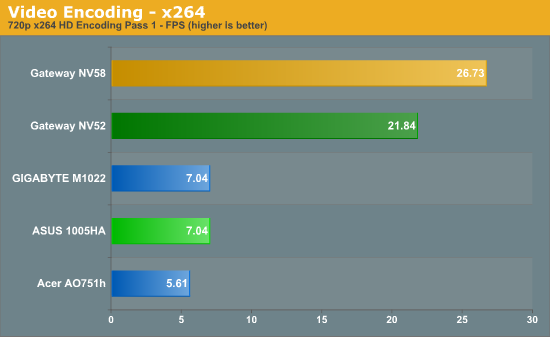
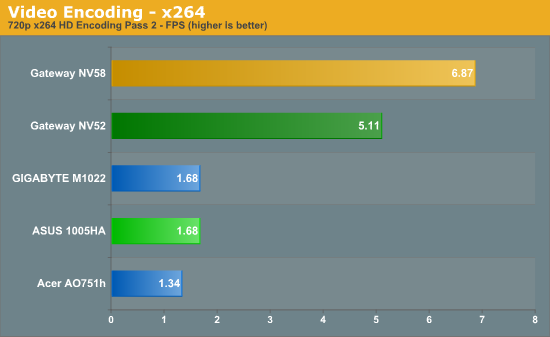
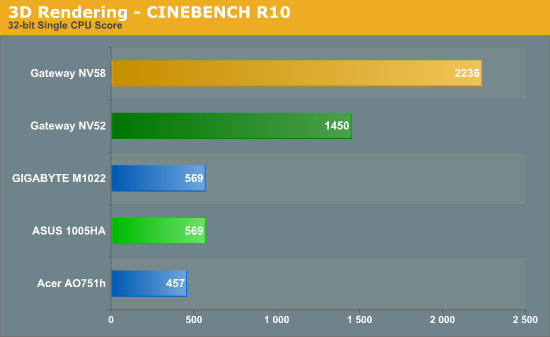
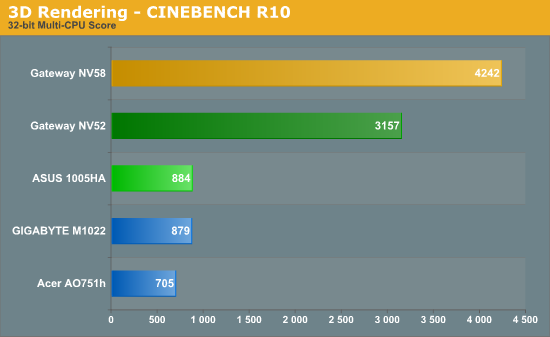
Starting with general application performance, the AMD-based NV52 is 142% faster than the 1005HA and the Intel-based NV58 is 192% faster in PCMark05. If we move to purely CPU limited tasks like 3D rendering and video encoding, the margin is often even greater: NV52 is 130% to 257% faster and the NV58 is 255% to 380% faster. Ouch! Do we even need to explain that the Intel Atom is anything but a high-performance CPU? It's worth noting that none of the netbooks we've tested so far can handle x264 720p (let alone 1080p) decoding; they drop frames like a bad habit. 720p DivX on the other hand works quite well, so we used that for one of our battery life tests on the next page. Update: As one of the readers pointed out, CoreAVC with Media Player Classic will handle x264 720p decode. If that's important to you, the $15 for CoreAVC is a worthy investment. We'll update with x264 battery life decoding results once the tests complete.
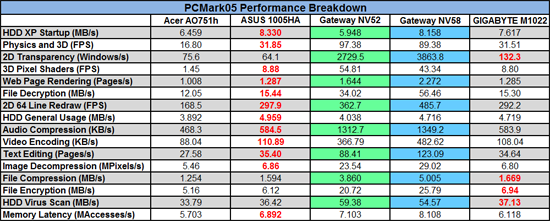 |
The detailed PCMark05 results tell a similar story, with the netbooks trailing entry-level notebooks in nearly every category, often by large margins. Graphics in particular show a huge discrepancy, with the NV52 coming in over 50X faster than the 1005HA in 2D Transparency and 40X faster in 3D Pixel Shaders. Part of the difference comes from OS - XP scores much lower on 2D Transparency than Vista; however, XP also scores higher on HDD tests, which accounts for the netbook scores being higher than the NV52. Testing all platforms with XP (not shown), only the HDD tests are close, which makes sense; the remaining tests favor the NV52 by 90% to 520% and the NV58 by 85% to 345%.
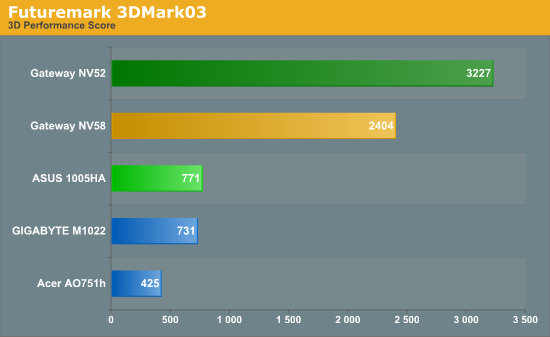
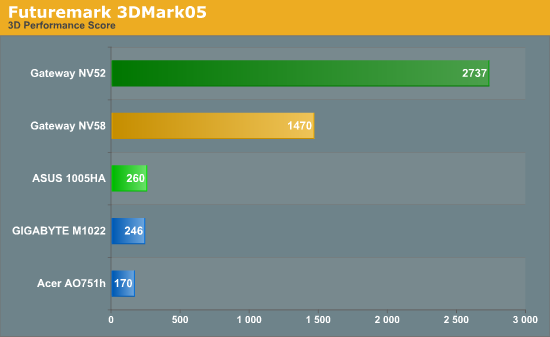
If general performance was bad, 3D performance is even worse. 3DMark03 -- a benchmark that focuses primarily on DirectX 8 performance -- has the GMA 4500MHD outperforming the outdated GMA 950 by 212%, and AMD's HD 3200 comes in 319% faster. Switching to a more modern DirectX 9 benchmark, 3DMark05 gives the 4500MHD a 465% advantage and the HD 3200 is nearly ten times as fast (953% faster). If you're planning to try to run any 3D games on these netbooks, you will definitely want to stick with older titles. The original Half-Life should work okay, for example, along with other games from 2000 and earlier. 2D titles should present fewer difficulties… Diablo 2 for example is a good option.
For those interested in other tasks, we were able to watch Hulu.com (360p) movies in fullscreen mode without difficulty. Standard YouTube videos also work fine -- in fact, here's one case where the low 1024x600 native resolution is actually a bonus. HD Hulu and YouTube videos are a different matter, with serious performance issues to the point where they are unwatchable. It's not clear if this is a limitation of the graphics chip, the Atom processor, or Adobe Flash -- or all of the above. As you can imagine, higher quality QuickTime videos (i.e. with H.264 encoding) are also a problem as there's simply not enough oomph to decode them properly. Stick with less complex codecs, however, and the 1005HA works well as a portable video device.
In contrast, the higher performance AMD and Intel laptops from Gateway have no problem with HD YouTube and other web content. H.264 playback is also possible, though the NV58 couldn't handle 1080p x264 content while the HD 3200 in the AMD system manages that task... and do we even need to mention how much better the NV52 is at gaming? Higher bitrate x264 videos aren't a serious need on netbooks, however, particularly those with 1024x600 LCD panels. Such videos may be nice to watch if you have them, but there's also the question of battery life when watching movies. As we'll see on the next page that's one area where the netbooks really trump regular laptops. Without further adieu, then, let's move on to battery life testing.
Netbook Battery Life Comparison
We've expanded our battery life testing on netbooks to include many scenarios, at least for this initial look. Since most netbooks don't include optical drives, we ripped our standard test DVD to a hard drive and copied those files over. Obviously there's a benefit to not powering a spinning DVD, but even without that advantage the netbooks provide much better battery life than higher performance laptops. Note also that battery results from the GIGABYTE M1022 are missing in several of the charts; at five or more hours (plus recharge time) per test, we'll be working on getting the remaining results for a couple more days.
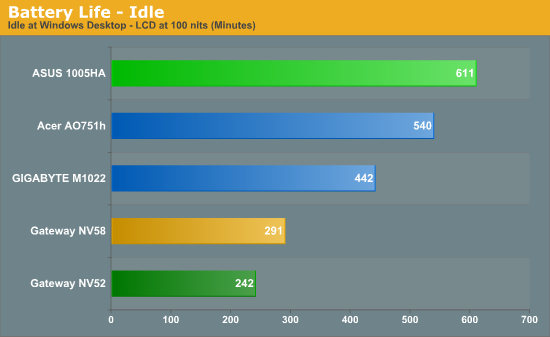
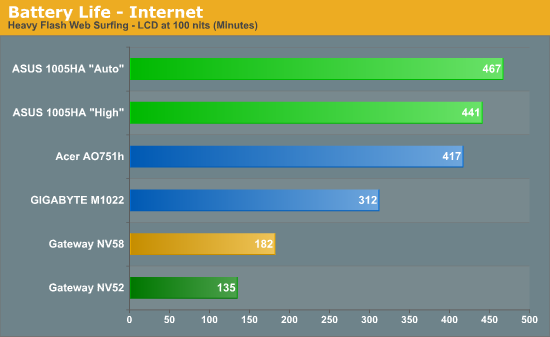
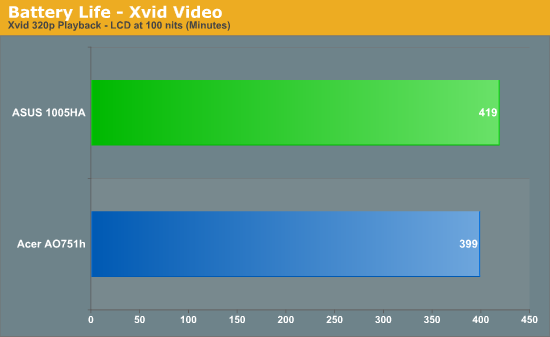
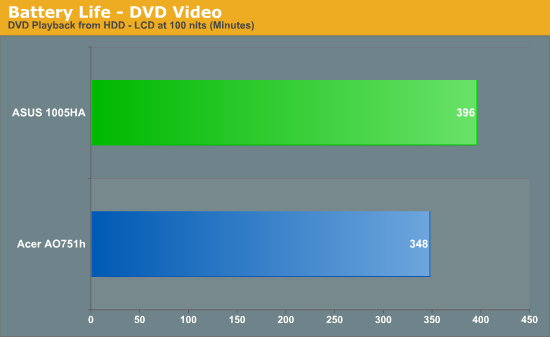
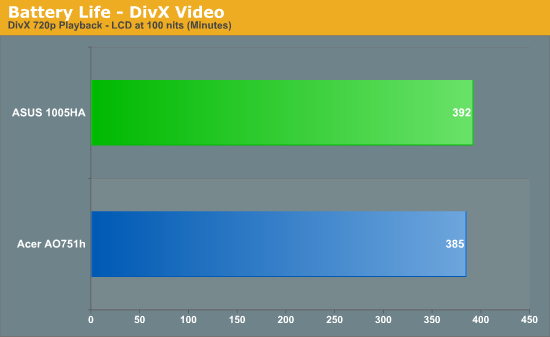
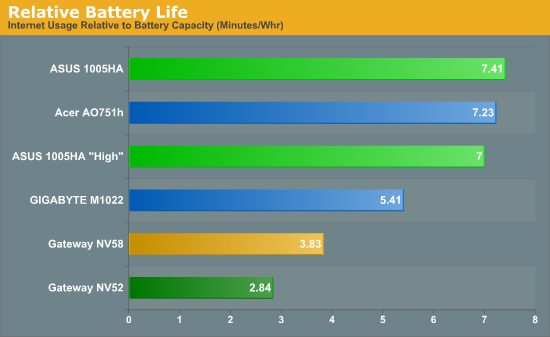
Few laptops are able to come anywhere close to the same battery life using a moderately sized battery, and the ASUS 1005HA in our worst-case test (720p DivX playback) still provides 35% more battery life than the Gateway NV58 at idle. Besides DVD playback from the hard drive, we included battery life testing using HD DivX and SD Xvid formats. It's interesting to note that the Acer 751h essentially ties the 1005HA in the DivX test, while it trails in most of the other battery life tests by over 10%. Xvid playback is also closer at only 5%, so the GMA 500 hardware looks like it handles certain video playback scenarios better than the GMA 950.
The ASUS 1005HA by default ships with their Super Hybrid Engine software enabled and set to "Auto" performance. This results in a 12% underclock on battery power, improving battery life in the Internet test by 5.6%. Considering most people buying netbooks aren't ultra concerned with raw performance in the first place, the boost in battery life is a nice extra. If you prefer to run the CPU at stock performance, selecting the "High Performance" setting within the Super Hybrid Engine utility will allow you to do so. You can see the difference between the two settings on the Internet and Relative Battery Life charts above. We ran the remaining tests using the "Auto" setting.
Note that we calibrated all of the test laptops to run at 100 nits brightness (give or take about 5% as many laptops don't provide fine enough control to hit 100 nits exactly). Considering the ASUS 1005HA and the Gigabyte M1022 have virtually identical hardware, we were a little surprised that the battery life relative to battery capacity favored the ASUS 1005HA by 37% (and we'll recheck that score before the final review). Either the battery in the M1022 is flaky or ASUS has done a lot more work in fine-tuning the power saving features on the 1005HA. However, even at idle we didn't reach the advertised 10.5 hours of battery life; we could likely do so if we reduce the LCD brightness to its minimum level, but that's not how most people will use their netbooks.
Overall, despite the 10.5 hour claim being somewhat exaggerated, the 1005HA routinely manages over 6.5 hours of battery life in situations that are known for taxing laptops. You'll have enough time to watch three or four full-length movies without recharging, if that's what you're after. If you stick to less strenuous usage like surfing the web or basic office tasks, getting eight hours or more out of the 1005HA between charges is possible. And you get all that in a package that only weighs 2.8 pounds; that's not something you'll get from a regular laptop.
Netbook LCD Quality
One of the things we immediately noticed with the 1005HA is that the LCD looked a lot better than other laptops we've tested recently. We ran our standard LCD quality tests using ColorEyes Display Pro to investigate further. It's not the best LCD we've ever seen in a laptop -- not by a long shot -- but compared to competing netbooks the LCD certainly has some strong points.
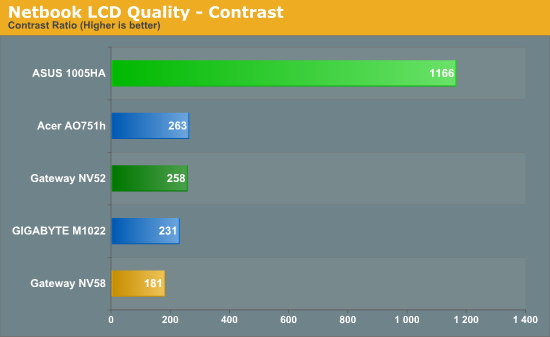
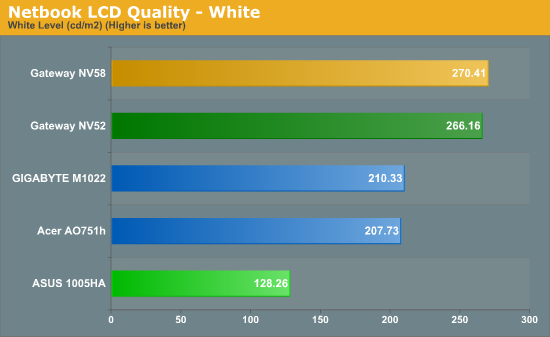
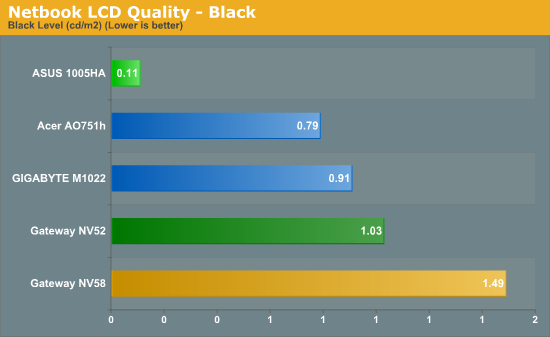
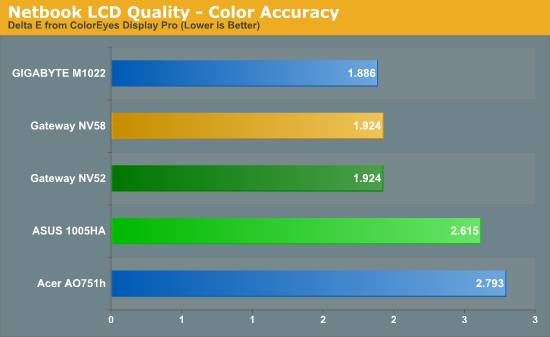
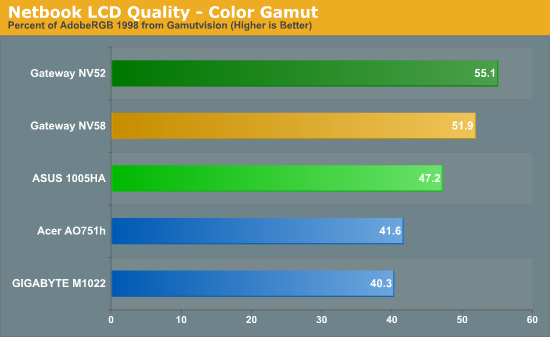
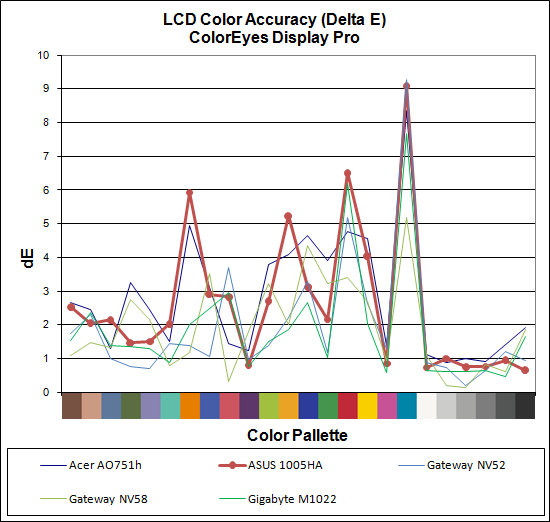
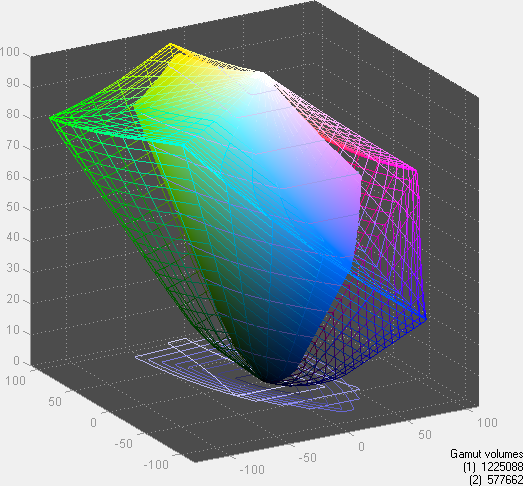
The reason this display stands out so much from the crowd becomes immediately obvious: the contrast ratio is significantly better than any of the other netbooks we've looked at (and better than any notebook we've looked at for that matter). Contrast ratio isn't everything, but a high contrast ratio helps to avoid the washed out look we've seen on a lot of laptop LCDs lately.
The other aspects of the LCD panel aren't quite as impressive. Color accuracy is typical of most laptops, as is the color gamut. Maximum brightness is also quite dim, at just 128 nits. Combined with a glossy LCD, the low maximum brightness is something that works well indoors but will definitely present problems outdoors. If you're hoping to carry this netbook around campus and work outdoors in the commons during nice weather, you'll probably be disappointed. We'd like ASUS to boost the LCD brightness 100% (~250 nits) while maintaining the high contrast ratio, but ASUS is at the mercy of the LCD panel manufacturers. Increasing the brightness could also reduce battery life if not done properly -- even at the same 100 nits we use during testing, it's clear that not all LCD panels are created equal.
Looking at two netbooks side-by-side, i.e. the 1005HA and the M1022, the high contrast ratio makes the 1005HA look brighter than it actually is. This is part of the problem with trying to match brightness levels without using a colorimeter, and it's why we use such tools to equalize our battery life tests. For indoor use like in a home, office, or classroom, the panel on the 1005HA is noticeably better than other laptops and netbooks. We just wish it had a brighter LED backlight.
Update: As one reader pointed out, the modding community has created a utility called "EeeCTL" that allows you to tweak the backlight brightness. Using the "Ultrabright" setting the LCD will run at ~250 nits while maintaining a 1000:1 contrast ratio. Power requirements will increase quite a bit at that brightness (over 2W, which is ~33% more at idle and ~25% more in Internet use), resulting in much lower battery life, but it is a nice option for when you're working in environments that benefit from brighter LCDs. You should still be able to get around 6 hours of battery life at 250 nits while surfing the web.
You Say You Want an Evolution…
After putting the ASUS 1005HA through a bunch of tests, we're happy to report that there are some tangible gains in battery life relative to the previous 1000HE. Other than that, there's not much to differentiate the two models. That in a nutshell describes much of the netbook market: all of the various products are extremely similar in terms of features and specifications. The only real differences are often more subjective, but keyboards, touch pads, and LCDs can still make or break a product.
When we compared the ASUS 1000HE with the MSI Wind U123, in some ways the U123 was a superior product. For the same price users received a larger capacity battery that resulted in roughly 40% more battery life, and they didn't even increase weight by a noticeable amount. Outside of battery life, however, we felt that the keyboard and especially the touchpad were better on the ASUS 1000HE. So how does the 1005HA compare?
The keyboard remains the same as far as we can tell, and that's a good thing. The 1005HA keyboard gave us no complaints. The touchpad is a bit trickier. We didn't have any serious issues, but we routinely activated the touchpad shortcuts for scrolling unintentionally. You can always disable those actions, but we feel their benefits outweigh the occasional errant activation. The longer we used the 1005HA, the more comfortable we became with the touchpad. Overall then, we'd rate that 1005HA as being equal to the 1000HE/1000HA in the ergonomics department.
Subjectively, you know the netbook is slow as soon as you start using it (unless you're coming from a pre-2004 laptop or something without enough RAM). Launching Internet Explorer (or Firefox, Chrome, Opera, or Safari for that matter) takes noticeably longer. Opening and rendering web pages takes noticeably longer. Interacting with Windows in general is far more sluggish. The detailed PCMark05 explain in numbers exactly what you'll experience with a netbook. An entry-level $500 laptop is about 50% faster at rendering simple web pages (and the difference increases with lots of Flash content). Loading Microsoft Office is similar in that the initial start times are slower and menus and dialogs are less responsive in terms of popping up. If you have a task start using a lot of CPU time, the pauses become far more common and distracting -- in other words, heavy multitasking isn't a good idea.
Does any of this make netbooks a horrible platform? Is it too much or just something you notice when you come from a faster system? Relative to a modern desktop, a netbook is going to feel painfully slow at times, but for $300-$375 and a lightweight portable we don't think it's a bad trade. Don't run tons of web pages in tabs, don't open eighteen applications at once, and you'll be fine. The performance charts really tell the story: netbooks like the 1005HA are slow, but they're still "fast enough". Sometimes that's all you really need.
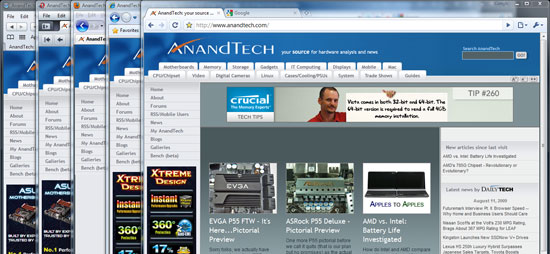 |
The most annoying aspect continues to be the low resolution LCD. The contrast ratio is great and it's at its best in movies; everywhere else could definitely benefit from a larger, higher resolution LCD. However, it will suffice for normal office use. Most web pages aren't designed for optimal viewing on a 1024x600 LCD panel - the majority of sites don't have a problem with the width, but the height is a real issue so expect to do a lot of scrolling. By the time you add the title bar, menus, tabs, address bar, status bar and task bar together, you're looking at about 1/3 of the vertical space without any useful material! Combine that with site banners and other content and you may not even get to the core of a website without scrolling down. That's why the touchpad gestures are useful, because you'll do a lot of scrolling on any netbook.
Incidentally, if you're looking for a minimalist browser, Google Chrome wins with only 83 pixels of vertical real-estate at the top (compared to 130 for Safari 4, 118 for Opera 9/10, 113 for Firefox 3.5, and 96 for IE8 -- click the above image for a full-size view). That's using default settings, of course, and it's possible to shrink down the vertical footprint of other browsers. The core problem of not having enough vertical viewing space remains, however, and fixing that issue isn't a simple solution. For example, the old 5:4 and 4:3 LCDs were nice on vertical viewing space, but they're not as nice for widescreen movies. Still, 1366x768 or 1280x800 LCDs would be a welcome addition for netbooks (and it's something already being addressed with other models).We mentioned it before, but it bears repeating: one of the changes made from the 1000HE is that it's now much more difficult to access the hard drive. Users looking to upgrade to an SSD might prefer the old models, which appear to be selling at slightly discounted prices. On the other hand, the old models also offered lower battery life, so you have to pick your poison. Personally, the thought of adding a relatively expensive SSD to an inexpensive netbook doesn't make a lot of sense. Hard drive access will certainly improve, but the bigger bottleneck is usually the slow Intel Atom processor. You might also consider upgrading the memory to 2GB (around $30).
Once you start looking at upgrades, however, the attractiveness of netbooks starts to fade. In fact, the only reason to stick with a netbook at that point is because you really want the long battery life. Our performance results included a $500 notebook that runs circles around any netbook in every category… except size, weight, and battery life. Certainly notebooks are far more versatile than netbooks, and we really don't recommend anyone plan to use a netbook as their sole computer system. They're great for a small portable computer that you can easily carry around all day, take some notes, surf the web, etc. As soon as you try to do something more taxing -- moderate gaming, HD videos, or even in general use -- the performance benefits of entry-level laptops are readily apparent.
Our advice is to use a netbook as your second or third PC. They fill that role very well, and with a price tag of under $400 they are very affordable compared to high-end CPUs and graphics cards. If you're like us, you already have a powerful desktop you can use at home, and you might have a reasonably powerful laptop/notebook. What you likely don't have is a three pound computer that you can use all day long without the need to recharge. If you're in the market for such a computer, netbooks are a perfect fit. They won't be everything to everyone, but they definitely fill an important niche. ASUS continues to lead among netbook manufacturers, which is fitting considering they started the market a couple years back. The 1005HA may not be a revolutionary product, but it evolves the netbook just enough to make it worthwhile.













